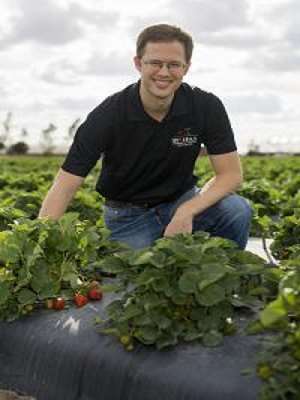By Brad Buck
When you bite into a Florida strawberry for Valentine’s Day or National Strawberry Day on Feb. 27, you savor sweetness and juice. That’s what you’ll find in all varieties bred by University of Florida Institute of Food and Agricultural Sciences researchers. The latest, ‘Florida Beauty,’ (U.S. PPAF) lives up to the UF/IFAS tradition.

As National Strawberry Day approaches on Feb. 27, we can look forward to even better-tasting fruit from UF/IFAS breeder Vance Whitaker as he tries to help Florida’s $360-million-a-year industry.
‘Florida Beauty,’ a collaboration between UF/IFAS and an Australian scientist, is in its early stages, said Whitaker, an associate professor of horticultural sciences at the UF/IFAS Gulf Coast Research and Education Center in Balm, Florida.
Scientists and growers are testing the newest variety in limited numbers this season and will be on a few hundred acres next year, he said. Seven different Florida growers are testing the new variety this season, putting about 20,000 plants to the test. Commercial growers also tested ‘Florida Beauty’ last year but in smaller numbers.
“It looked promising enough to conduct growing trials in larger numbers this season,” Whitaker said.
‘Florida Beauty’ looks somewhat like ‘Florida Radiance’ (Pat. PP20, 363) but taste similar to Sweet Sensation(R) ‘Florida127.’ (Pat. PP25, 574)
“Growers are interested in the fact that it can be planted earlier than the current varieties,” Whitaker said. “It is more suited to the early part of the planting period, the last week of September. It starts producing fruit quickly in early to mid-November and fruits consistently thereafter without becoming overly vegetative, despite the high temperatures in central Florida in September and October.”
Whitaker estimates Florida growers will plant about 400 acres of ‘Florida Beauty’ during the 2017-18 season. Its performance next season will largely determine to what extent it is adopted in the industry, he said.
The latest UF/IFAS variety came about through research between Whitaker and Australian scientists – an international seed exchange program that’s been around for several years. Queensland, Australia, is the global region most similar to Central Florida in terms of climate and growing practices, Whitaker said.
‘Florida Beauty’ is a cross between the UF/IFAS-bred ‘Florida Radiance’ and an Australian selection that also had some UF/IFAS background. Australian strawberry breeder Mark Herrington sent the seeds to UF/IFAS, Whitaker said.
Strawberries are the first fruit to ripen every year. The bright, red, juicy berries are delicious and good for you. Each bite contains vitamins, antioxidants and fiber, according to the U.S. Department of Agriculture.
Source: ufl.edu